Cave Diving Expedition Report – 2009 – Samar, Philippines
Langun-Gobingob Cave Diving Expedition
2009 – Samar, Philippines
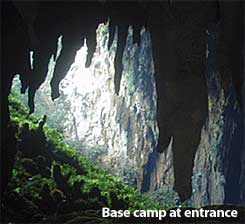 The cave systems of Samar, Philippines are some of the most extraordinary in the world and a cave explorer’s paradise. With more Karst caves than anywhere else on the planet, Samar has thousands of known caves and probably thousands more to be found.
The cave systems of Samar, Philippines are some of the most extraordinary in the world and a cave explorer’s paradise. With more Karst caves than anywhere else on the planet, Samar has thousands of known caves and probably thousands more to be found.
In August, 2009, three intrepid cave divers set out to explore the underwater sections of the largest cave in the Philippines, the Langun-Gobingob Cave near the town of Calbiga. Initially discovered by an Italian expedition in 1987, the limits of the cave had been reached as far as above-water exploration allowed.
Expedition leader Bruce Konefe, one of Asia’s top cave explorers, Thomas Bodis and William Hudson tell the story of how they embarked on a fantastic mission of exploration, one which would change the scope and name of the cave forever.
Our expedition had already had significant successes over the last several days. Both Bruce and Thomas had done previous exploration in Samar, and had discovered two caves two years ago but had been prevented from diving by equipment failure. The three of us set out to find these caves again, as they are deep in the jungles and so engulfed by the rain forest that one could be standing next to a cave and be unaware of its presence.
Despite enduring leeches and extremely rugged terrain for hours on end, the two previous caves remained elusive, but luck was with us. We ended up discovering no less than three new caves within just a two day period.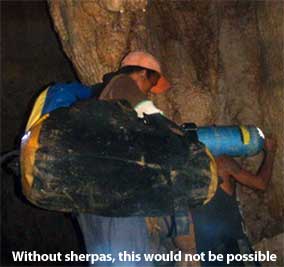 Assisted by a team of staunch porters bearing the brunt of the load of tanks and equipment, each of the three caves was explored.
Assisted by a team of staunch porters bearing the brunt of the load of tanks and equipment, each of the three caves was explored.
The first was carried out by Thomas, an expert mountaineer and spelunker, and required a twenty-five meter rappel into a massive collapse. Despite its promising appearance, the underwater portion of the cave turned out to be only two pools disconnected from the aquifer.
The second cave, also requiring ropes to access, was explored by William. It turned out to be highly decorated and comprised several levels over 21 meters deep.
The third, dived by the whole team, lay at the foot of a several hundred meter long cliff and consisted of three narrow fissures descending into the mountain face. These fissures were so narrow that we were all hard pressed to squeeze through the narrow gaps, frequently in zero visibility silt out conditions.
All three caves were challenges, but they were just the warm ups for the massive Calbiga exploration.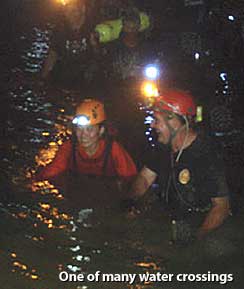 For Calbiga, we teamed up with Joni Bonifacio, the de facto cave expert in the area. Joni has done much of the exploration in the region, and schedules regular expeditions for cave enthusiasts.
For Calbiga, we teamed up with Joni Bonifacio, the de facto cave expert in the area. Joni has done much of the exploration in the region, and schedules regular expeditions for cave enthusiasts.
This was the first time, however, that anybody had shown up with scuba gear. A side-mounted tank configuration had already been decided upon both to help ease the load on the porters, and to enable us to remove our tanks underwater and squeeze through the narrowest of passages.
Twelve porters were required to carry all of the equipment, and it seemed that everyone in the tiny village serving as the base camp turned out to see this strange load of gear.After a three and a half hour trek over mountainous terrain, the entrance to Gobingob-Langun came into sight. A massive, orchestra shell shaped indention at the base of a huge cliff was penetrated by an apparently narrow horizontal slit.
Its true size, however, was masked by the scale of its surroundings, and in fact was nearly fifty meters wide and fifteen tall. The entire entourage donned carbide lamps, which proved extremely effective in the impenetrable darkness. The sound of cave crickets and swallows echoed all around, and as we penetrated deeper and deeper, the enormity of this cave became apparent.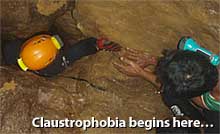 Steam rose from our bodies in the humidity, and appeared like clouds floating toward the black limestone sky far above.
Steam rose from our bodies in the humidity, and appeared like clouds floating toward the black limestone sky far above.
After an hour and a half of clamoring over rock fall, we came to a sudden halt. Below us, twenty stories below, lay the cave floor. As far as our torches could penetrate the blackness, shapes rose from the floor like a cityscape. Spires and skyscrapers appeared, and between us and them a vertical wall scalable only with ropes and determination. The porters slowly lowered our gear down one tank at a time; then it was our turn. Strapping into our harnesses, each of us eased our way down, our hands and feet vainly searching for holds anywhere on the slick stone face.
At last we all made the descent. Looking above us, we were all in awe of the face we had just spent two hours conquering.
What had appeared from above to be a cityscape was transformed into a forest of decorated speleothems worthy of Jules Verne. Ranging from two to five meters high, each was decorated with petal-like extrusions in fantastically intricate patterns. Two spires towered over the others, one a narrow point stabbing upwards like a Buddhist temple, the other a massive column reaching toward the ceiling nearly a hundred meters above. The sight was overwhelming, and on par with the much more well known caves of the world.
We moved past the ghostly forest to what would be the first of many river crossings and soon entered a lower chamber with the world turned topsy-turvy. No stalagmites here, only huge stalactites hanging like chandeliers everywhere. The ground turned from rock to a muddy goo. Slogging our way through the muck up to our calves, we plodded onward, across the river again and again, frequently neck deep in the waters.
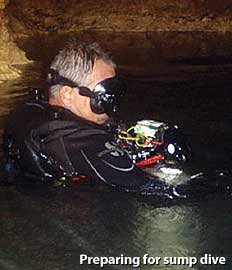 After hours of surreal landscapes, we saw a glimmer of light ahead: the Langun entrance. As we neared, the opening began to resemble something out of The Lost World. Lush green foliage, shimmering in the light from above, rose up a mountain-sized collapse to the surface. We were dwarfed by its enormity, and had a diplodocus or brachiosaurus lumbered across the scene, none of us would have been surprised.
After hours of surreal landscapes, we saw a glimmer of light ahead: the Langun entrance. As we neared, the opening began to resemble something out of The Lost World. Lush green foliage, shimmering in the light from above, rose up a mountain-sized collapse to the surface. We were dwarfed by its enormity, and had a diplodocus or brachiosaurus lumbered across the scene, none of us would have been surprised.
At the base of this tremendous collapse we pitched what would be our subterranean base camp for the next two nights. The stars rotated in the night sky beyond this window to the upper world. A two meter snake which Joni deemed highly poisonous was found not too far from our mats. Cobras have been seen in this portion of the cave, so we surrounded our sleeping area with torches to hopefully deter any unpleasant encounters. After a dinner of rice and adobo, a tasty Philippine pork marinade dish, we lay down, exhausted but looking forward to our diving adventure the next day.
The next morning we rose early for the final push to the cave extents, and immediately we were challenged. A narrow fissure, wide enough only to slip down sideways, dropped about four meters into neck deep cold water below. Once again pulling out the climbing rope, we lowered ourselves down hand over hand, with only a splash and a few choice words from below to indicate a successful drop. Our faces barely above water, we inched forward to the only other exit from this watery pit: a tiny vertical slit, perhaps two and a half feet high by a foot at its widest, starting a meter above the water level. We braced each other up to the opening, but from then on it was all fingers and toes, pulling and pushing on our sides. Each person breathed a sigh of relief after exiting the narrow fissure, massaging our few scrapes and bruises.
Continuing downward, we passed two spectacular rim stone terraces, spotted in a leopard-like fashion by drippings from above. A quagmire of knee-deep mud that literally sucked off our boots followed, an area we jokingly dubbed the Valley of Lost Soles. We finally reached our point of decision, whether to explore the upstream or downstream end of the final passage. As the water level was low, we decided on the downstream section.
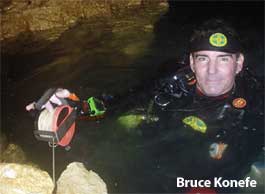 The river ran five meters below us down a vertical slope, so once again out came the climbing ropes. We donned our kit on the top of the cliff, rappelled down, then had our tanks lowered down to us. Once in, we headed downstream, but the sound of a waterfall warned us that a portage and yet another rappel was in store. The waterfall was beautiful, and within ten meters the water flowed under the furthest explored point. Off with the kit, down a line, and on again for the last push.
The river ran five meters below us down a vertical slope, so once again out came the climbing ropes. We donned our kit on the top of the cliff, rappelled down, then had our tanks lowered down to us. Once in, we headed downstream, but the sound of a waterfall warned us that a portage and yet another rappel was in store. The waterfall was beautiful, and within ten meters the water flowed under the furthest explored point. Off with the kit, down a line, and on again for the last push.
Adrenalin filled our veins as we finally started our dive. Bruce tied off the line, and we descended. The current was not as strong as we expected considering the amount of water on the waterfall above, a very good sign considering that a strong current might indicate a narrow passage that could suck us helplessly into the abyss. This passage could be wide, which could portent further chambers beyond. We descended to the floor at about six meters, and lined onward. We sloped upward, and suddenly, we saw a flat surface above. This could either turn out to be a small air pocket or a giant chamber.
We carefully surfaced, and then we knew, we had discovered a entirely new section of cave. At the point we surfaced, a ceiling rose about twenty meters above, and the chamber was about fifty meters wide. The remains of three ancient openings, two on right and one large one on the left, clogged with blackened debris, sloped down to the water. A band of rocks lay between us and what lay ahead, so we un-kitted and started our exploration.
The rocks in our path were easily negotiated, so we lined out, following the river through a rounded chamber about fifteen meters wide by five high. Breathing air that no humans had ever tasted, Bruce and William continued onward while Thomas remained with the equipment as a reference point for return should an emergency occur. The passage continued straight approximately three hundred meters, then opened up again. A vast cliff appeared ahead cutting across our path, and the river turned to the left. The roar of a waterfall echoed from beyond. From what we could see and hear, we estimated the length of the new section to approach a kilometer in length, with possible new sections yet to follow.
Reaching the end of our line, we reluctantly realized that it was time to rejoin Thomas and return to the rest of the group. William reeled up, and we all knew that despite all of our efforts, we would need more equipment to further explore and map this vast new expanse of cave. We had accomplished our goal, and had experienced the thrill of discovery. The planning for a subsequent expedition was already racing through each of our minds.
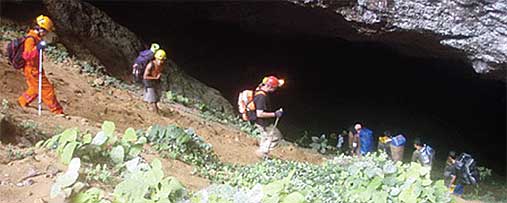
We returned back through the sump we had navigated and again saw the glimmer of Joni’s carbide torch. Another passage, though, seemed to extend from the right side of the sump. We followed it down, repeating our previous preparations, only to find that this was the far side of the same wide underwater passage. We did get two trips to our new find, just on different sides of the passageway. Laughing, we quickly returned and started the trek out.
We roped back up the waterfall, swam back to the cliff wall we had descended, and thought we were done when Joni pointed out another hole from which water was gently flowing. This entrance was vertical, starting at the surface. Thomas had already begun his climb up the slope, so Bruce and William proceeded downward. After a drop of only about four meters, the fault turned horizontal and after about ten meters became too narrow to negotiate even in side tanks. We returned to the surface, made our ascent from the water, and began the long trip upwards to our base camp.
Soon after we returned to camp, the bats began their nightly migration. Millions of bats, blackening the vast hole above, spun dizzily for ten minutes, then it was over. A fitting end to a grand day of exploration. The next morning we made our way up the Jurassic slope back into the light of day. A few hours of mountain climbing later, clinging to the slope by vines and trees all the while, we triumphantly reentered the village from which our adventure began.
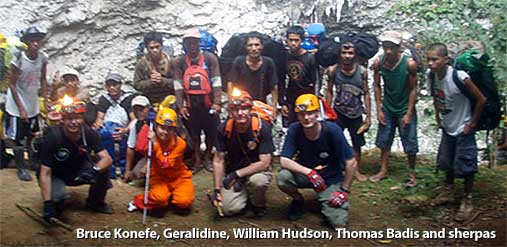 In the Philippines, a new name is added for each section of cave discovered. We named our new section Lurodpon the Tagalog word for “Underwater Cave.” The new full name for the system is Langun-Gobingob-Lorodpon Cave, a syllabic mouthful but one well befitting one of the most spectacular systems on earth.
In the Philippines, a new name is added for each section of cave discovered. We named our new section Lurodpon the Tagalog word for “Underwater Cave.” The new full name for the system is Langun-Gobingob-Lorodpon Cave, a syllabic mouthful but one well befitting one of the most spectacular systems on earth.
Only through the support of organizations and individuals can exploration of our subterranean world continue. We would like to thank the following persons and agencies for supporting and aiding this extremely successful expedition: OMS; Cochran Computers; American Nitrox Divers International (ANDI); Mermaids Dive Center, Pattaya, Thailand; and Joni Bonifacio, Trexplore, Catbalogan City, Philippines. — William Hudson
CALBIGA CAVE DIVING EXPEDITION 2009
August 16-18, 2009
Langun-Gobingob Cave
Calbiga,Samar
“DISCOVER LURODPON CAVE”
On August 17 2009 between 1:05 and 2:05 Calbiga Cave the largest cave in the Philippines was opened up to a whole new world. A team of underwater cave divers entered a sump and found unexplored passages, streams and chambers that no one has ever seen before. The expedition lasted 3 days and two nights in the cave system. The team consisted of 3 underwater cave explorers, 12 porters and there Philippino guide. Repelling gear, tents, food plus underwater diving equipment were carried in by the team of divers and porters. Seventy meters walls had to be repelled down, streams crossed, mountains climbed had to be overtaken to make it to the water sump.
NEW DISCOVER CAVE SYSTEM:
CAVE NAME: LURODPON CAVE
DATE: AUGUST 17, 2009
TIME: 1:05 PM – 2:05 PM
Langun-Gobingob Cave – Old Name
Gobingob-Langun-Lurodpon Cave – New Name
THE CAVE DIVERS EXPLORER:
1. Bruce Konefe 48 years old – American
2. Thomas Bodis 45 years old – German
3. Willian Hudson 51 years old – American
GUEST:
1. Gereldine Antonio 25 years old (Only women in the Expedition) Alabang,Manila
TOURIST GUIDE / CAVE GUIDE :
1. Joni A. Bonifacio 30 years old Trexplore Catbalogan,Samar
PORTERS IN BRGY. PANAYURAN CALBIGA,SAMAR:
1. Lando Tagbigayan 37 years old “President local cave guides”
2. Joel Pacayra 37 years old
3. Nerio Mabag 44 years old
4. Ludi Pacayra 40 years old
5. Rappy Tabigayan 19 years old
6. Renato Jacla 46 years old
7. Alvin Rapales 16 years old
8. Danilo Balondo 35 years old
9. Anito Abansia 38 years old
10. Lupi Nardo 35 years old
11. Remmy Jacla 41 years old
12. Lito Tabigayan 34 years old

